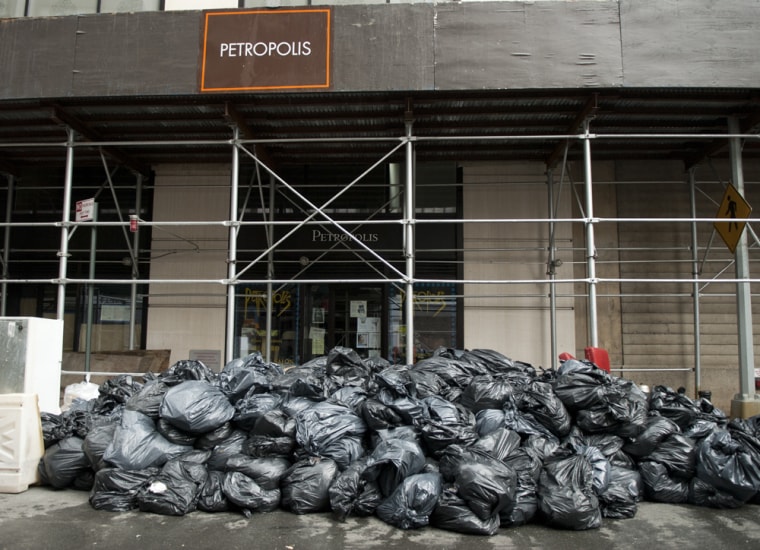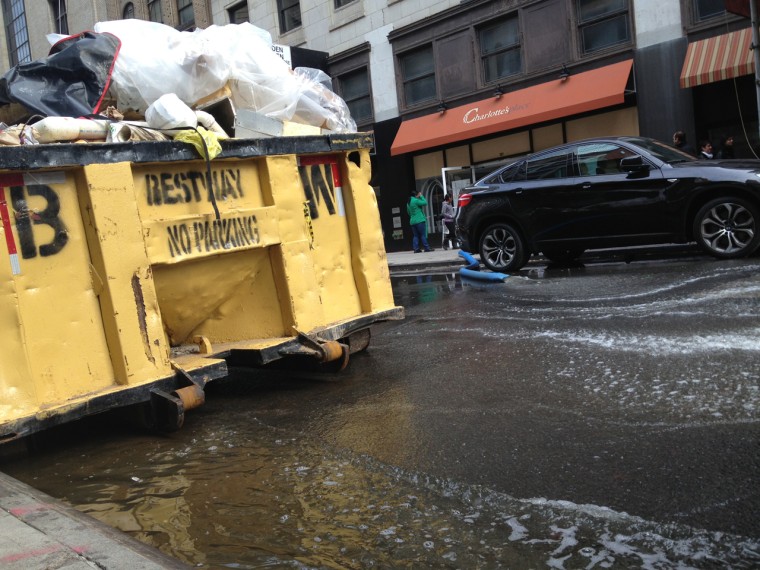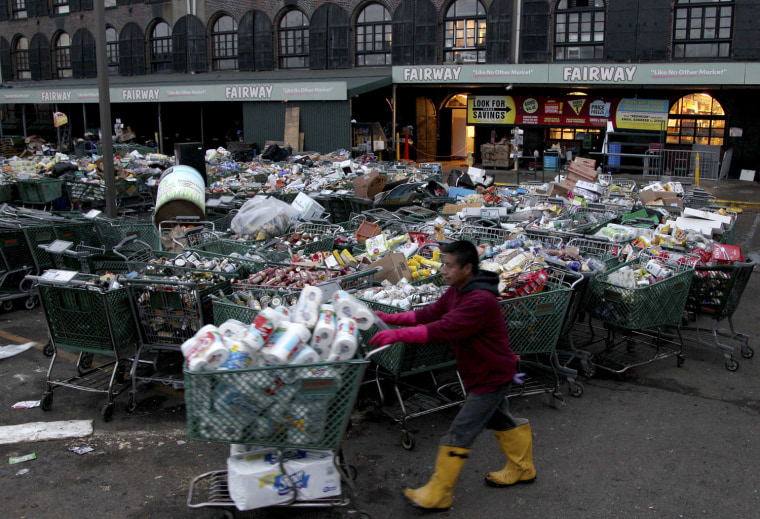
By Andrew Mach and Maggie Fox, NBC News
NEW YORK -- Fish guts flowing down a Union Square street. Untreated sewage in the Hudson River. Spoiled Haagen-Dazs dumped on a deli floor. Toilets that won't flush.
Superstorm Sandy has left a mess behind in a city never exactly known for its cleanliness.
In Manhattan, as power remained out for many customers below 39th street, Rod Zindani, owner of the Best of New York deli on Water St., stood by large plastic trash bags filled with melted single-serve tubs of Haagen-Dazs ice cream. “That’s $1,000 to $1,500 worth,” he told CNBC.
It's all got to go.
"Everybody's throwing out food. All the cooked short ribs, cooked pork, salsas had to go,” said Alfredo Vicuna, the head of kitchen at Tortaria, near Union Square in lower Manhattan. “It will stay good for about 24 hours, but after it got above 40 degrees, we can't use it. I don't even want to think about how much we had to throw out. It's not nice to see. The boss is literally crying right now about how much we lost."
Nearby, Carlos Solorzano watched a restaurant worker in a white chef’s coat hose away fish guts left behind in the street by sanitation workers. Along the curb, a tiny river of pink liquid, sprinkled with fish bones, blue and red octopus parts and bits of mackerel, flowed away.
"When we came back after the storm, some of the food was already rotten, all of the ice cream was melted, all of the fish had already spoiled. We had to throw out about 200 pounds of meat. That's a lot of business, that's their whole menu," said Solorzano, superintendent of the building housing the restaurant.

Refrigerators will keep food cold enough only for about four hours with the door closed. While bottled drinks and nonperishable foods such as peanut butter won’t go bad, any meat, cheese, eggs or cooked food has to go. Freezers only stay cold enough for about 48 hours.
At least one group of New Yorkers might be happy to see all that food tossed into the street: the rats. However, despite fears that rats would invade the city to feast on the garbage or that thousands would be flushed from the depths by floodwaters, a spokeswoman for the New York Department of Health and Mental Hygiene said there's no evidence of an increase in rat activity.
As wary New Yorkers eye the soggy mess left behind by Sandy, some have expressed concern about an outbreak of disease. But experts say fears of cholera or dysentery from the floodwaters likely are overblown.
“The truth is, it’s fairly rare” in developed countries such as the United States, said Dr. Martin Makary, a gastrointestinal specialist at Johns Hopkins University in Baltimore. That’s because people aren’t putting infected sewage into the system in the first place. Even after Hurricane Katrina devastated the Gulf states in 2005, water-borne disease was not a widespread problem, Makary said.
Also, people who collected water in bathtubs, bottles and other containers ahead of the storm should be able to drink it safely even after a few days without refrigeration, Makary said.

“The GI system is extremely resilient to contaminated water,” he said. “Sometimes people insist on sterile water, bottled water. But the most important thing is to avoid cross contamination with sewage. Water that simply been in the tub or out on the counter for a couple of days is likely safe.”
Brett Sherman, 59, and her husband had filled the bathtub and stocked up on bottled water as emergency experts advise. But they finally fled their West Village apartment when their high-rise ran out of water.
"We live in a building about 18 stories high with a water tank on top," Sherman said by telephone from Montclair, N.J., where her stepdaughter lives and has power. "Somebody said that the water in the tank would last a couple of days but it didn't even last 24 hours. I was surprised by that."
That meant toilets stopped working. Lucky for that bathtub full of water. "A lot of the toilets in buildings like that don't have tanks," Sherman said. "You can just take a bucket of water and pour it in and it flushes. We discovered that," she added. "But can you imagine that going on in hundreds of buildings?"

The city health department has advice for what people can do when the water comes back on after having been off -- just run the water for 30 seconds until it is cold and clear. " Replace all ice machine filters and beverage dispenser filters, and flush all water lines for five minutes," the web site advises.
Many of the restaurants and shops in Tribeca were still closed and boarded up, save for the few that had generators. But the streets were largely clear and devoid of any excessive amounts of garbage on Thursday. The scene was a far cry from only two days ago, when locals said many of the streets were completely flooded.
According to the website of the New York City Department of Sanitation -- which says it collects 12,000 tons of refuse and recycling on a normal day -- the city was making its regularly scheduled garbage collections “as storm conditions permit.” Recycling pickup was suspended; on its Twitter feed Thursday, @NYCSanitation was advising customers to “try to store [recyclables] as long as you can, please.” The sanitation department was also handling hurricane debris cleanup citywide. “Hang in and we will all get through this. We’re New Yorkers!” it tweeted.
The waters that surround Manhattan -- The Hudson River, East River, New York Harbor -- remain filthy because wastewater treatment plants dumped untreated sewage into them. People shouldn't even touch the water, authorities said.
“Activities such as swimming, canoeing, kayaking, windsurfing or any other water activity that would entail possible direct contact with the water should be avoided until further notice,” the Department of Environmental Protection cautions.
Bacteria in the water can cause an itchy rash and could cause infections if it gets into cuts.
Many residents in high-rises without electricity and people living in flooded areas still lack fresh water supplies. New York City mayor Michael Bloomberg and the city’s Department of Environmental Protection say water coming out of the taps is safe. And the department has set up portable drinking water stations to areas where water service is down, such as Breezy Point and Rockaway, which were especially hard hit by the storm and by fire.
With contributions from Elizabeth Chuck.
More content from NBCNews.com:
- 'Pure mayhem' as New York City tries to get back to work
- Wind, flames, Our Fathers: The inside story of Breezy Point's terrible night
- War veterans hit Sandy's front lines for rescues, cleanup
- NYC-area airports up and running, albeit slowly
- New York trick-or-treaters defy Sandy to celebrate Halloween
- As National Guard comes to rescue, so do NJ residents — with power outlets
- How to avoid post-storm insurance and repair scams
- For some New Yorkers, it's back to business as usual
- New Jersey investigating reports of price gouging
- Your Sandy photos: Show us the heroes in your life
- Sandy's aftermath: How you can help